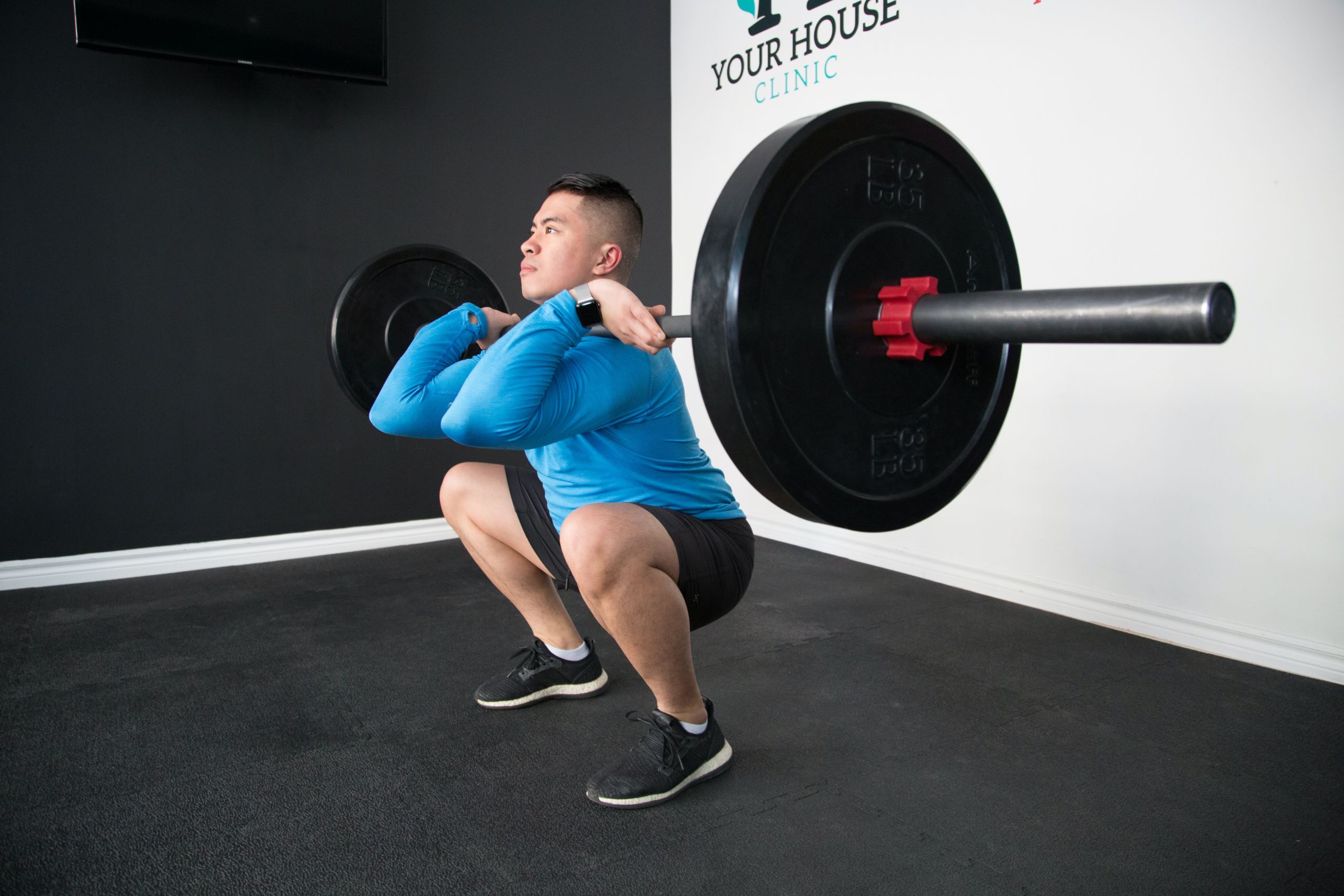10 Tips to Avoid Weight Training Injuries After 30
January 19, 2021
There’s nothing wrong with lifting heavy. I still do so in my 30’s. But you can’t train exactly like you did in your teens and twenties. Here are 10 Tips to Avoid Weight Training Injuries After 30.
Before going any further, grab a copy of your chiseled muscle cheatsheet. This step-by-step guide gives you everything you need to know to add 10-15 pounds of pure muscle.
Most lifters hit the gym in their teens full of piss and vinegar. They keep training the exact same way for years…despite their body throwing daggers of pain into overused and abused joints.
And you won’t ever come close to the strong, lean, and healthy body you want if you’re beating the snot out of your joints every time you hit the gym.
So, how can you get jacked, not hurt?
Here are ten crucial lessons from the Bach Performance Online Coaching Program:
1. Master Exercise Execution
Joint position dictates muscle function. You should own every inch of each rep. Control is crucial every step of the way.
Consider using a tempo such as 3-1-1-0. This would
The first number is the eccentric (lowering portion.)
The second is any pause at the bottom of the eccentric (also known as the midpoint.)
The third is the lifting phase (the way up), while the last number is any squeeze or hold in the contracted position.
By emphasizing tempo you’ll be able to improve your mind-muscle connection for better muscle growth and be more in-tune with your exercise execution.
2. Paused Reps
Except for explosive work, try adding pauses between the eccentric and concentric…like the bottom of a squat. Stored energy will dissipate and you’ll need to overcome the resistance using your muscles, not the stretch response. Pause and hold for 2-3 seconds before the concentric part of the lift.
Related: Paused Reps for Strength and Stability
3. Warm Up Sets
Before your main lift of the day, you should do 2 warm-up sets of about five reps with short rest. These will make sure you’re warmed up for the exercise at hand and will gauge how “ready” you are on any given day. Let’s say your workout says deadlift 5×5 and you can do 275 pounds for five reps.
If you take sets 1-2 to deadlift, say, 135 and 185 pounds, you’ve cut your total workload in half by using weights that aren’t heavy enough to elicit a muscle-building response.
Do not track these, but note them. With your first exercise, do a warm-up set with roughly 50, then 65% of where you’d like your first work set to begin.
These shouldn’t fatigue you or take much time, but they will keep you healthy and performing at your best. It’s important to note these are not listed in your app, but are important nonetheless.
Ramping Sets over Straight Sets.
Let’s use the 5×5 rep scheme as an example again.
Performing straight sets would mean you’d use the same weight for all sets.
Ramping sets would mean you start a little bit lower, but increase the weight as you go through the workout.
Here’s the difference:
Straight sets: Bench Press 5×5, 225 for all sets.
Ramping sets: 5×5 but 205×5, 215×5, 225×5, 235×5, 235×5.
In the ramping sets you take a little more time to warm up and optimize technique, but you’re rewarded with fewer injuries and faster gains.
Related: Ascending Sets
4. Walk and Warm Daily to avoid weight training injuries
Most lifters work the typical desk job, sitting in the same position for 8-12 hours a day, 300 days per year. After sitting, the muscles responsible for preventing unwanted movement and transferring force to your core are relatively deactivated. They’ve had no reason to move, so they take a nap.
This makes jumping into a similar flexed position (deadlift, squat) risky. By training the core first in the workout, you’re activating dormant muscles so you can perform safely and effectively.
If these muscles aren’t firing, how can you expect them to prevent your spine from folding like the Bills in the Super Bowl once you add heavyweight?
You can’t.
On off days, wake up five minutes early and do this warm-up first in the morning. If you wake up five minutes early, you have no excuse NOT to do it.
We recommend 10,000 steps per day. This will improve blood flow to simulate recovery. It’s great for your mental health and waistline, too.
Related: https://bachperformance.com/weight-training-warm-up/
5. Avoid NSAIDS
Over-the-counter painkillers have been shown to shut down protein synthesis while trashing your organs.
This means poppin’ pills to deal with joint pain after a workout is negating your recovery at the cellular level.
6. Supplement With Curcumin
Curcumin is a powerful natural compound that reduces inflammation and pain.
Evidence shows it may aid in supporting healthy cholesterol levels, aid in optimizing hormone levels, and reducing body fat.
7. Sleep 7+ Hours Per Night
Moderate sleep deprivation (4-6 hours) leads to increased inflammatory markers even in healthy adults.
The majority of testosterone release occurs at night. If your sleep is trash, your insulin sensitivity, recovery, and testosterone levels are soon to follow.
Proper sleep reduces inflammation and cortisol, which are crucial for joint health and stress. Sex Hormone Binding Globulin (SHGB), which binds up testosterone in your blood, also decreases with adequate sleep.
So, how much sleep do you need?
Take a peek at the 2011 Chicago sleep study. 28 students slept 8 hours per night at home for one week. The following week participants spent 11 days in the laboratory for 3 nights of 10-hour bedtimes from 10 PM to 8 AM in a fully rested condition.
In the third and final week participants had 8 nights of 5-hour bedtimes (from 12:30 AM to 5:30 AM).
The result?
In one-week testosterone levels plummeted by 10-15% of sleeping five hours per night. Put in perspective, testosterone levels have been shown to decrease by 1-2% every year after 30 years old.
By sleeping 5 hours per night, you’re giving yourself testosterone levels of someone 10-15 years your elder. And the inflammatory markers lead to joint pain and more sinister disease like metabolic syndrome and heart disease.
8. Consume Less Sugar, Alcohol, and Inflammatory Foods
Refined sugar, processed food, drugs, and alcohol have been repeatedly shown to increase inflammatory markers. The same can be said if you have food sensitivities and allergies.
The most common are dairy and gluten, but they’re highly variable. Pay attention to how your body feels after certain foods and remove problematic foods.
 9. Reduce Training Volume to avoid weight training injuries
9. Reduce Training Volume to avoid weight training injuries
Too many lifters train with high-volume routines they can’t grow from, let alone recover.
If your technique isn’t pristine, you’re piling POOR volume on top of dysfunction. That’s a recipe for injury. When you optimize rep quality, you can do LESS in the gym and achieve better results.
10. Avoid Generic Workouts and Cookie-cutter Plans
The biggest mistake men make is to follow the same, cookie-cutter programs and expect different results.
Avoid Weight Training Injuries: The Last Word
Fact of the matter is, as life changes, your program needs to adapt with you.
When you look at it objectively you have…
-
- Less time in your hectic schedule
- Less room for error in your training
- More aches, pains, and injuries to work-around
- More stress from work and life to navigate
- More pressure to perform your best
- A family or business to lead with energy and resilience
Your training needs to be hand-crafted and built around your life in order to improve it, not consume it.
So, what’s the answer for overcoming joint pain and low energy and getting the results you deserve?
This is: Chiseled Muscle Cheatsheet








